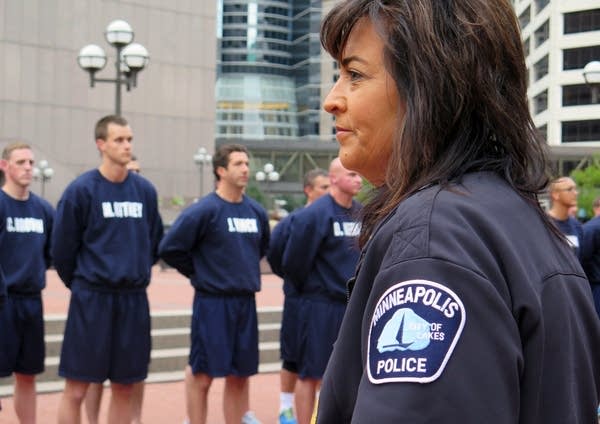Minneapolis budgets $300,000 for police bias training

Go Deeper.
Create an account or log in to save stories.
Like this?
Thanks for liking this story! We have added it to a list of your favorite stories.
When a shooting happened right outside her door, Natalie Johnson Lee approached one of the victims to try to calm her down and then called police. Johnson Lee, who's a former City Council member and African-American, says she was trying to help.
When the police arrived, they treated her with suspicion, she said:
"I basically say, 'I'm maybe one of the people that called, you've got a young man in the hallway right there bleeding out.'
"'Well, who are you?'
Turn Up Your Support
MPR News helps you turn down the noise and build shared understanding. Turn up your support for this public resource and keep trusted journalism accessible to all.
"I said, 'I live across the street.'
"'Well, why are you out here? What do you want?'
"And I said, 'I'm trying to help you.' I said, 'I'm not in the way, I'm trying to tell you what is going on.'"
Experiences like hers, said Johnson Lee, keep African-Americans from calling police. That longstanding problem, together with recent police shootings of unarmed black men, prompted the U.S. Justice Department to invest $1.5 million to teach police officers across the country to recognize their own biases.
In Minneapolis, police began training earlier this year, using federal dollars. And the city has budgeted $300,000 for further police bias training.
By now, says the Minneapolis Police Department, most officers have been taught to recognize when they're falling back on stereotypes, even subconsciously.
Lorie Fridell, a professor of criminology at the University of South Florida, trained some of the officers in Minneapolis. She said implicit bias can affect behavior even in individuals who reject stereotypes.
"In our grandparents' time, when bias and prejudice manifested, it was most likely going to be in the form of explicit biases," she said. "So biases and prejudices still exist, but it's as if they've gone underground."
The training asks officers to make split-second decisions when shown images of an unarmed black man versus an armed white man, or an armed woman.
"What that officer needs to see in those videos is people who are a threat, that's just as likely to be female as male, just as likely to be white as black, just as likely to be well dressed as not well dressed," Fridell said.
Social psychologists say bias in policing is hard to measure. That's why critics doubt programs like this actually work. Minneapolis resident Mike Spangenberg told the City Council recently that brief training sessions are not enough.
"I spent over a decade in education and have spent much of that time unlearning a lot of the mis-education that I received as a white person growing up in the Twin Cities," he said. "And I also know that a couple of days of training could not have done that for me."
Police Chief Janeé Harteau said the training is the first of many steps to reduce bias across the force. Two-thirds of the most recent class of community service officers, she said, are people of color.
"I now actually interview everybody personally that walks through the door of the Minneapolis Police Department to try to gauge bias, to also ensure that what makes a really good officer is a wide lens of the world, a wide view and empathy," Harteau said.
Next year the city plans to spend a total of $1.5 million for not only the bias training, but for body cameras as well. The decision comes in the wake of recent protests against Minneapolis police after the shooting death of Jamar Clark, an African-American man.
The state Bureau of Criminal Apprehension and the FBI are still investigating the shooting.


